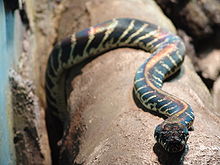Simalia boeleni
This article needs additional citations for verification. (August 2021) |
| Simalia boeleni | |
|---|---|

| |
| Scientific classification | |
| Kingdom: | Animalia |
| Phylum: | Chordata |
| Class: | Reptilia |
| Order: | Squamata |
| Suborder: | Serpentes |
| Family: | Pythonidae |
| Genus: | Simalia |
| Species: | S. boeleni
|
| Binomial name | |
| Simalia boeleni (Brongersma, 1953)
| |
| Synonyms | |
Simalia boeleni is a species of python, a nonvenomous snake in the family Pythonidae. The species is endemic to the mountains of New Guinea.[1][4] No subspecies are currently recognized.[3][5]

Etymology[]
The specific name, boeleni, is in honor of K.W.J. Boelen, M.D., who collected the holotype specimen.[6][7]
Description[]
In S. boeleni adults, the upperside color pattern is dark bluish-black or purplish-black, and the anterior part of the underside is white to pale yellow. The white extends up the flanks as a series of streaks. The upper and lower lips are also patterned with pale or whitish labial scales. The black portions are commonly iridescent with an oil-slick-like sheen. The body is stocky and the head large. Neonates are predominantly red upon emerging from the egg. Gradual black pigmentation presents itself as the neonate grows and sheds. Ontogenetic color charge begins as the juvenile snake approaches 1 m (39 in) in length, usually around 2 years of age. Adults may be up to 3 m (9.8 ft) in total length (including tail).[8]
Conservation status[]
The unmistakable and famed Boelen's python receives the highest legal protection possible in Papua New Guinea. It is currently listed on CITES Appendix II. It is difficult to truly assess the conservation status of these snakes, as they are incredibly secretive and difficult to find in the wild.[9]
Common names[]
Locally, S. boeleni is also known as the blu moran or papa graun. Within Indonesia, it has several names depending on which language is used. The common Indonesian names of this snake are sanca hitam, sanca bulan, piton hitam, and ular buleni.[citation needed]
Geographic range[]
S. boeleni is found in Indonesia (Western New Guinea in the Paniai Lakes region) and Papua New Guinea (the provinces of Eastern Highlands, Central and Morobe, and Goodenough Island).[citation needed]
The type locality given is "Dimija (3[°] 56' S, 136[°] 18' E), Wissel Lakes, Dutch New Guinea, about 1750 m (5700 feet) above sea-level" [Western New Guinea, Indonesia].[2]
Habitat[]
S. boeleni inhabits forested montane regions at elevations of 1,000–2,000 m (3,300–6,600 ft).[1] It is generally encountered on the forest floor, but is also reckoned to be an able climber.[citation needed]
Diet[]
The diet of S. boeleni consists of small mammals, ground-nesting birds,[1] and lizards.[citation needed]
Captivity[]
S. boeleni is considered to be highly desirable by private keepers due to its beauty, but is also exceptionally rare in collections.[10] Although captive-born snakes are fairly hardy in captivity,[11] wild-caught individuals are considerably more difficult to keep successfully.[12] Captive breeding is exceedingly rare, and the conditions necessary are still unclear.[13] Many specific strategies have been employed to attempt to get these rare snakes to breed.[14]
References[]
- ^ Jump up to: a b c d e f , O'Shea M, (2018). "Simalia boeleni ". IUCN Red List of Threatened Species. 2018: e.T42494046A42494055. doi:10.2305/IUCN.UK.2018-2.RLTS.T42494046A42494055.en. Retrieved 3 January 2021.CS1 maint: multiple names: authors list (link)
- ^ Jump up to: a b McDiarmid RW, Campbell JA, (1999). Snake Species of the World: A Taxonomic and Geographic Reference, Volume 1. Washington, District of Columbia: Herpetologists' League. 511 pp. ISBN 1-893777-00-6 (series). ISBN 1-893777-01-4 (volume).
- ^ Jump up to: a b c Simalia boeleni at the Reptarium.cz Reptile Database. Accessed 20 October 2015.
- ^ Jump up to: a b (1987). Living Snakes of the World in Color. New York: Sterling Publishers. 480 pp. ISBN 0-8069-6460-X.
- ^ "Morelia boeleni ". Integrated Taxonomic Information System. Retrieved 20 October 2015.
- ^ Brongersma, 1953. p. 317.
- ^ , , (2011). The Eponym Dictionary of Reptiles. Baltimore: Johns Hopkins University Press. xiii + 296 pp. ISBN 978-1-4214-0135-5. (Morelia boeleni, p. 29).
- ^ "Description of Natural History and Geography By Marc A. Spataro". www.boelenspythons.com.[dead link]
- ^ Spataro, Marc. "Natural History". Boelens Python Group. Retrieved 27 February 2019.[dead link]
- ^ "The Boelen's Python Group WELCOME". www.boelenspythons.com.[dead link]
- ^ "HATCHLINGS/SUB-ADULTS By Marc A. Spataro". www.boelenspythons.com.[dead link]
- ^ "ACCLIMATING WILD-CAUGHTS By Marc A. Spataro". www.boelenspythons.com.[dead link]
- ^ "Morelia boeleni Captive Reproduction By Marc A. Spataro". www.boelenspythons.com.[dead link]
- ^ Spataro, Marc. "Reproductive Strategies". Boelen's Python Group.[dead link]
Further reading[]
- Flagle, Ari R.; Stoops, Erik D. (2009). Black python: Morelia boeleni. (Contributions to Natural History, Vol. 26). Frankfurt: Chimaira Buchhandelsgesellschaft mbh. 160 pp. ISBN 9783930612864.
- Brongersma LD (1953). "Zoology Notes on New Guinean Reptiles and Amphibians II". Proc. Koninklijke Nederlandse Akademie van Wetenschappen, Amsterdam (Series C) 56: 317–325. (Liasis boeleni , new species, p. 317.)
External links[]
| Wikimedia Commons has media related to Morelia boeleni. |
- Boelen's python site & forums.
- Boelen's Python Site by Ari R. Flagle.
- IUCN Red List data deficient species
- Morelia (snake)
- Endemic fauna of New Guinea
- Reptiles of Papua New Guinea
- Reptiles of Western New Guinea
- Reptiles described in 1953
- Taxa named by Leo Brongersma
- Snakes of New Guinea
